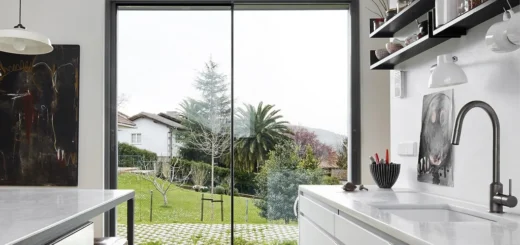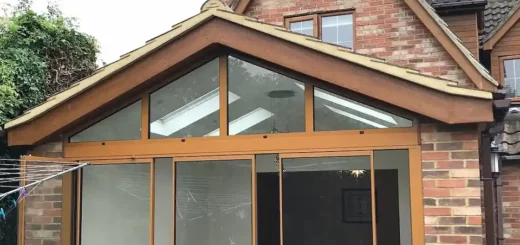A Complete Guide to Concertina Glass Doors
Table of Contents
Introduction to Concertina Glass Doors
Concertina glass doors offer a unique way to open up your living space. These doors fold back on themselves, much like the musical instrument they’re named after. They’re made up of multiple glass panels connected by hinges, allowing them to fold and stack neatly to one side when opened.
Different Names for Concertina Doors
You might hear concertina glass doors called by various names. Bi-folding doors, accordion doors, or folding glass doors all refer to the same type of door system. The term ‘bi-fold’ is often used because the doors typically fold in pairs. ‘Accordion’ describes the way these doors compress like the musical instrument when opened.
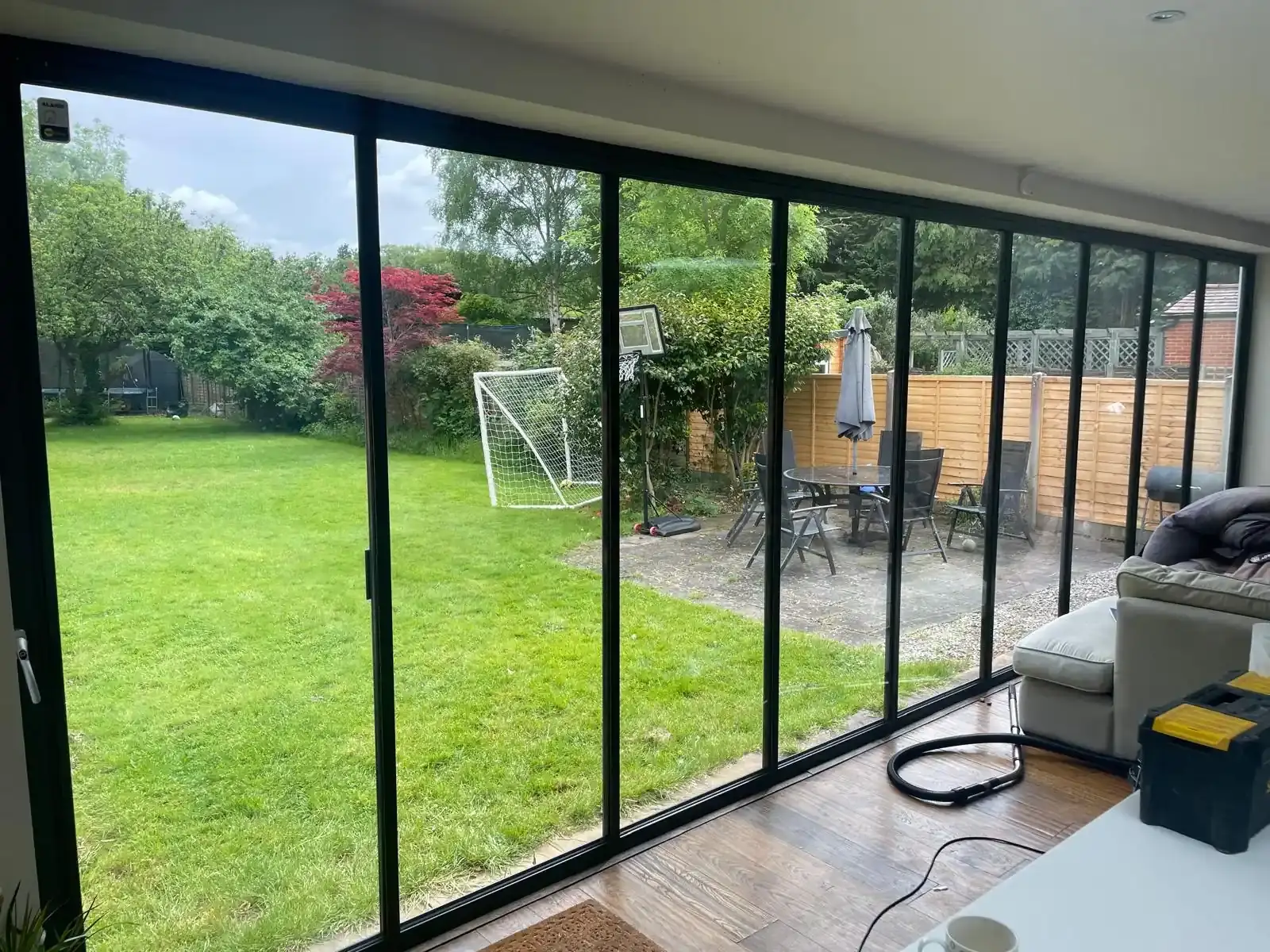
In some regions, you’ll hear them called ‘folding sliding doors’ or simply ‘folding doors’. These names all point to the same innovative door design that’s becoming increasingly popular in British homes. Regardless of what you call them, concertina glass doors function in the same way.
Concertina Door Mechanics
The mechanics behind concertina glass doors are surprisingly straightforward. A track system guides the door panels as they open and close. This track is usually fitted at the top of the door frame, with a less obtrusive guide at the bottom. When you push or pull the lead door, the other panels follow suit, folding against each other as they move along the track.
Key Components
At the heart of concertina glass doors are their hinges and rollers. High-quality hinges ensure smooth movement between panels, while sturdy rollers support the weight of the glass and frame as they glide along the track. The number of panels can vary, typically ranging from two to eight, depending on the width of the opening.
Glass panels make up the bulk of each door section. These are usually double-glazed for improved insulation, though triple-glazing is also an option for those seeking extra thermal efficiency. The frames holding these glass panels come in various materials, each with its own set of benefits.
Weather seals seals run along the edges of each panel, ensuring that when the doors are closed, they form a weathertight barrier. This helps to keep your home warm in winter and cool in summer, while also keeping out drafts and moisture.
Slide and Fold Door Systems
Slide and fold door systems offer a variation on the classic glass concertina doors design. These doors combine the features of sliding doors with the folding capability of concertina doors. Unlike standard concertina glass doors, which fold from one side, slide and fold systems allow the panels to individually slide along a track before the folding action begins.
Advantages of Slide and Fold Doors
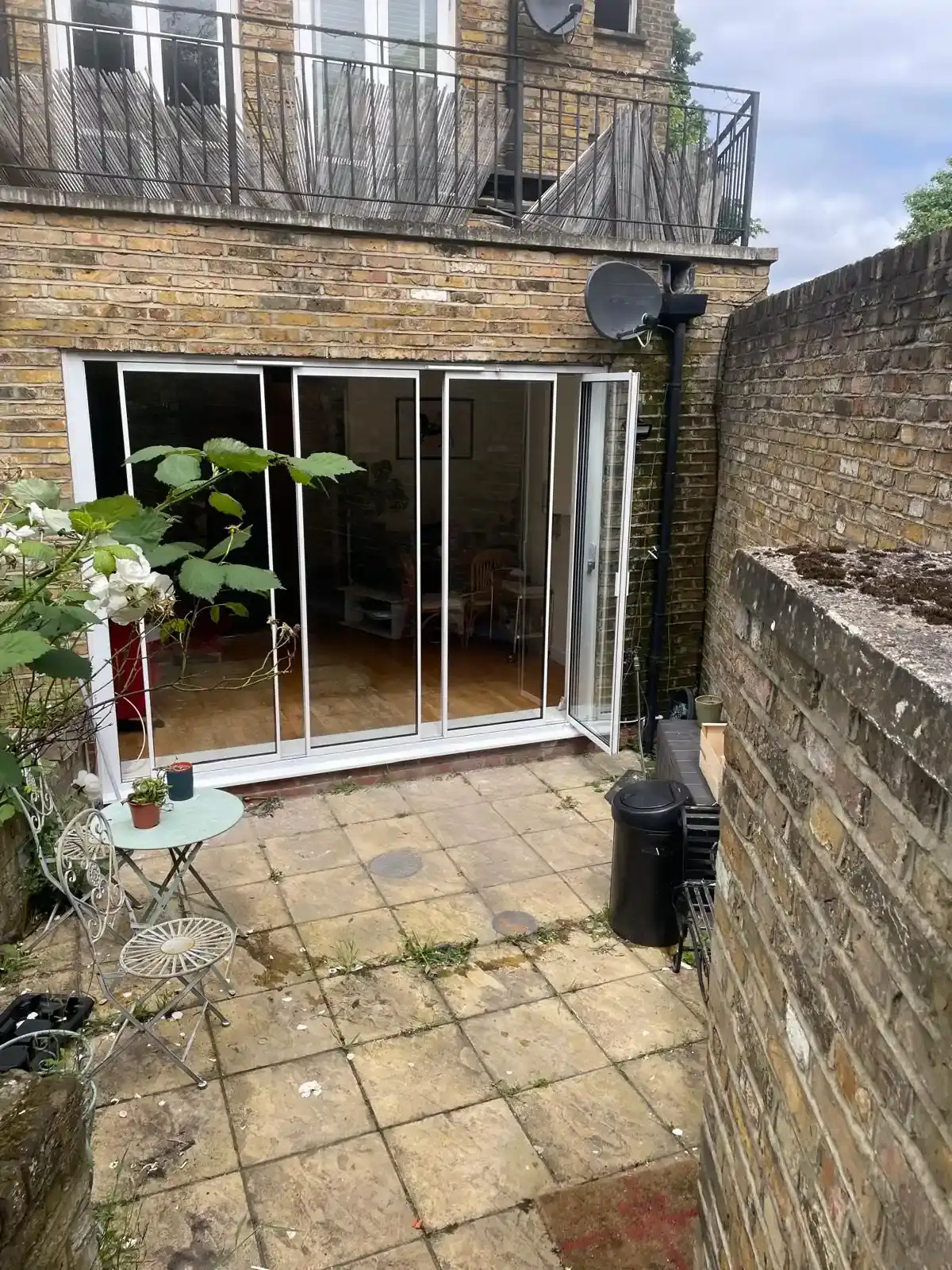
Slide and fold doors bring several benefits to the table. They’re particularly useful in spaces where a traditional swing door might be impractical, or where you want to open up a large area without the panels protruding too far into the room or garden. Glass concertina doors with a slide and fold mechanism can create wider openings than standard patio doors, making them ideal for large spaces.
The sliding feature of these doors allows for partial opening, giving you more control over ventilation and access. On days when you don’t need the full opening, you can simply slide one panel for quick entry or to let in a breeze. This flexibility is a key advantage of slide and fold systems over standard concertina glass doors.
Another benefit is the smooth operation. The initial sliding movement reduces the effort needed to start the folding action, making these doors easier to use, especially for larger installations. This can be particularly helpful for older users or those with mobility issues.
Choosing Between Slide and Fold and Glass Concertina Doors
Deciding between slide and fold and standard concertina glass doors depends on your specific needs and the layout of the area. If you have a wide opening and want the option to partially open the doors without folding all panels, a slide and fold system might be the better choice. These systems work well in situations where you need to save space or want more flexibility in how you use your doors.
Standard glazed concertina doors, on the other hand, might be preferable if you want a simpler mechanism or if you always plan to open the entire door system. Narrow bifold doors can be more suitable for smaller openings or where you want a completely clear opening when the doors are folded back.
The choice also depends on the aesthetic you’re after. Slide and fold doors often have a sleeker look when partially opened, as the panels stack more neatly.
Frame Materials for Glass Concertina Doors
The frame material you choose for your concertina glass doors can greatly impact their appearance, durability, and thermal performance. Common options include aluminium, uPVC, timber, and composite materials.
Aluminium Door Frames
Aluminium frames are a popular choice for concertina glass doors due to their strength and slim profile. These frames allow for larger glass panels, maximising the amount of light that enters your space. Aluminium is also highly resistant to corrosion, making it a good option for coastal areas where salt air can be an issue.
Despite being a metal, modern aluminium frames for glazed concertina doors are designed with thermal breaks. These breaks reduce heat transfer, improving the overall energy efficiency of the doors. Aluminium frames come in a wide range of colours and finishes, allowing you to match them to your home’s style.
One potential drawback of aluminium is that it can feel cold to the touch in winter. However, this is rarely an issue with properly installed concertina glass doors, as the frames are typically separated from the interior by the glass panels.
uPVC Door Frames
uPVC, or unplasticised polyvinyl chloride, is a cost-effective option for concertina glass doors. It’s known for its excellent insulation properties, helping to keep your home warm in winter and cool in summer. uPVC is also low maintenance, requiring only occasional cleaning to keep it looking good.
Glass concertina doors with uPVC frames are available in a variety of colours and wood-grain effects. While traditionally associated with white window frames, modern uPVC can mimic the appearance of timber or even aluminium. This material is resistant to fading, peeling, and flaking, maintaining its appearance over time.
One limitation of uPVC is that it can’t achieve the same slim sightlines as aluminium. The frames tend to be chunkier, which might not suit every aesthetic preference.
Glass Types for Concertina Doors
The glass you choose for your concertina doors plays a key role in their performance and appearance. Different types of glass offer varying levels of insulation, safety, and light control. When selecting glass for concertina doors, it’s important to consider factors such as energy efficiency, security, and your specific environmental conditions.
Double and Triple Glazing
Double glazing is the standard option for most external bifold doors. It consists of two panes of glass with a gap between them, usually filled with argon gas or a vacuum. This design improves thermal insulation compared to single glazing, helping to keep your home warm in winter and cool in summer. Double glazed concertina doors strike a balance between performance and cost.
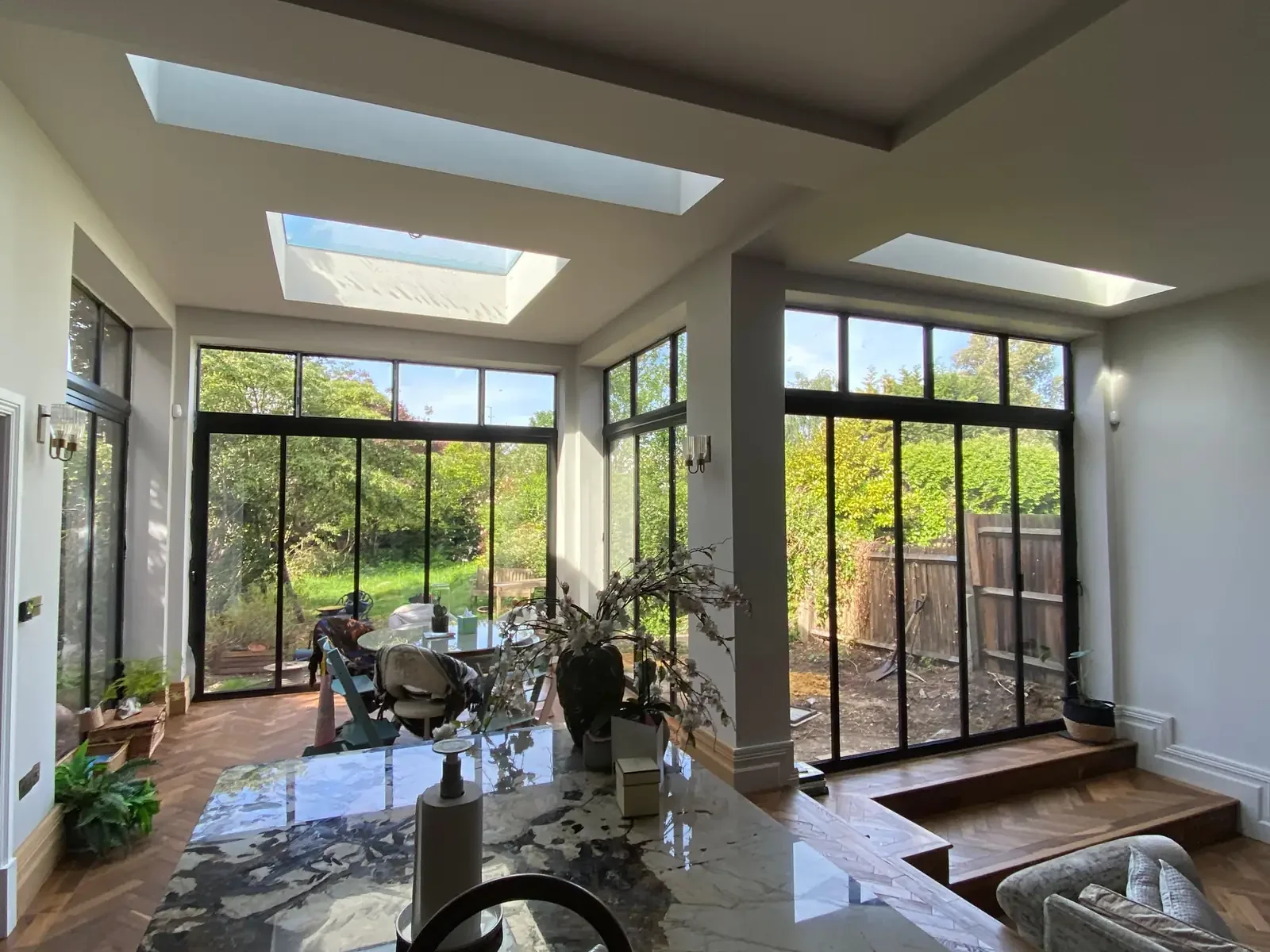
Triple glazing takes insulation a step further by adding a third pane of glass. While more expensive, triple glazed concertina glass doors offer superior thermal performance. They’re particularly useful in colder climates or for north-facing installations where heat loss is a concern. The extra pane also provides better sound insulation, which can be beneficial if you live in a noisy area.
However, triple glazing does have some drawbacks. The additional weight can put more strain on the door mechanisms, potentially affecting their longevity. It also reduces the amount of solar gain, which might be undesirable in cooler climates where you want to benefit from the sun’s warmth.
Safety Glass
Safety is an important aspect of glazed concertina doors. Toughened glass is often used as it’s around five times stronger than standard glass. If broken, it shatters into small, rounded pieces rather than sharp shards, reducing the risk of injury. Toughened glass is a good choice for concertina glass doors in family homes or areas with high foot traffic.
Laminated glass offers another safety option. It consists of two or more sheets of glass bonded together with a layer of polyvinyl butyral (PVB) between them. If the glass breaks, the PVB layer holds the pieces together, preventing them from falling out of the frame. This makes laminated glass an excellent choice for glass concertina doors in upper-floor installations or areas where security is a priority.
Some manufacturers offer concertina doors with a combination of toughened and laminated glass for maximum safety and security. This can be particularly reassuring for ground floor installations or homes in exposed locations.
Solar Control Glass
Solar control glass is designed to reduce the amount of heat that enters your home through bifold patio doors while still allowing plenty of light. This type of glass has a special coating that reflects a portion of the sun’s heat. It’s particularly useful for south-facing glazed concertina doors or in warmer climates where overheating can be an issue.
There are different levels of solar control available, allowing you to balance heat reduction with light transmission. Some types of solar control glass can block up to 80% of the sun’s heat while still letting through most of the visible light. This can help keep your home cooler in summer without making it feel dark or gloomy.
Solar control glass can also help protect your furniture and flooring from fading and your skin from ageing due to UV exposure. Many types of solar control glass used in concertina glass doors block a significant portion of UV rays, helping to preserve the colour of your interior furnishings.
Customising Your Glass Concertina Doors
Concertina glass doors offer numerous customisation options to suit your personal style and practical needs. From decorative elements to hardware choices, these doors can be tailored to complement your home’s architecture and your lifestyle preferences.
Georgian Bar Designs
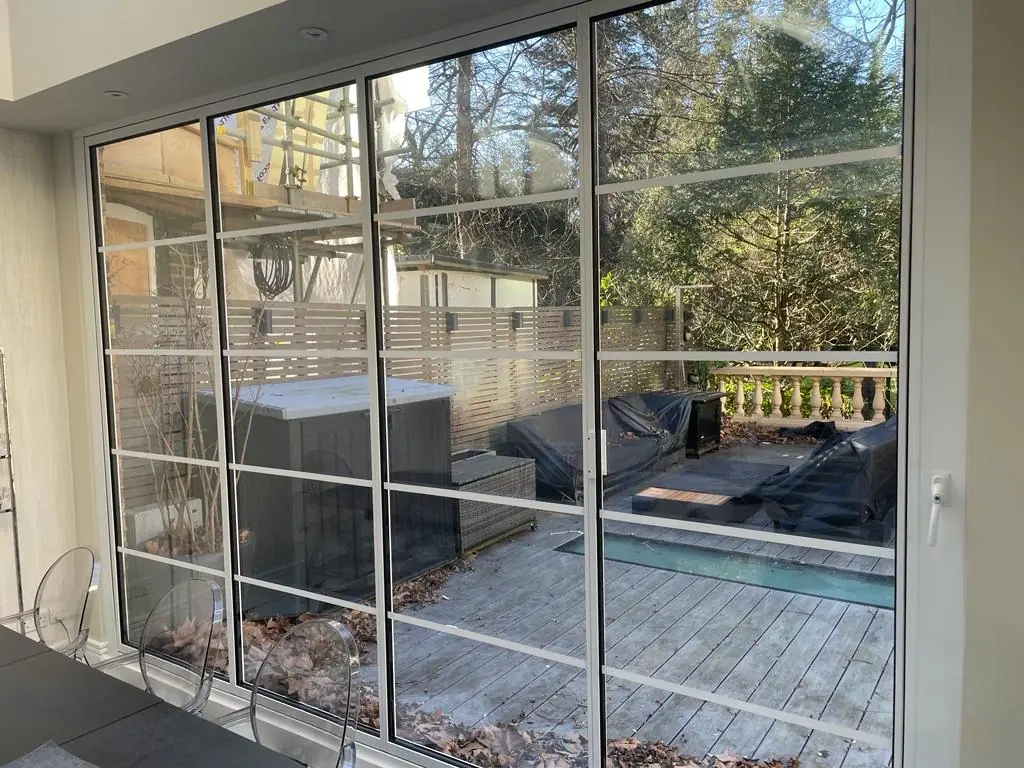
Georgian bars are a popular design feature that can add character to concertina glass doors. These bars, which are typically made of the same material as the door frame, are applied to the glass to create the appearance of smaller panes. This design harks back to traditional window styles, where glass was only available in smaller sections.
Modern Georgian bars for glass concertina doors are usually applied to the surface of the glass or sandwiched between the panes in double or triple glazing. This gives the classic look without compromising on the thermal efficiency of the doors. You can choose from various patterns, such as grid-like designs or more intricate layouts, to achieve the desired aesthetic.
Concertina doors with Georgian bars can be particularly effective in blending with period properties or adding a touch of traditional charm to more contemporary homes. They offer a way to break up large glass expanses, which some homeowners find more visually appealing than uninterrupted glazing.
Built-in Blind Systems
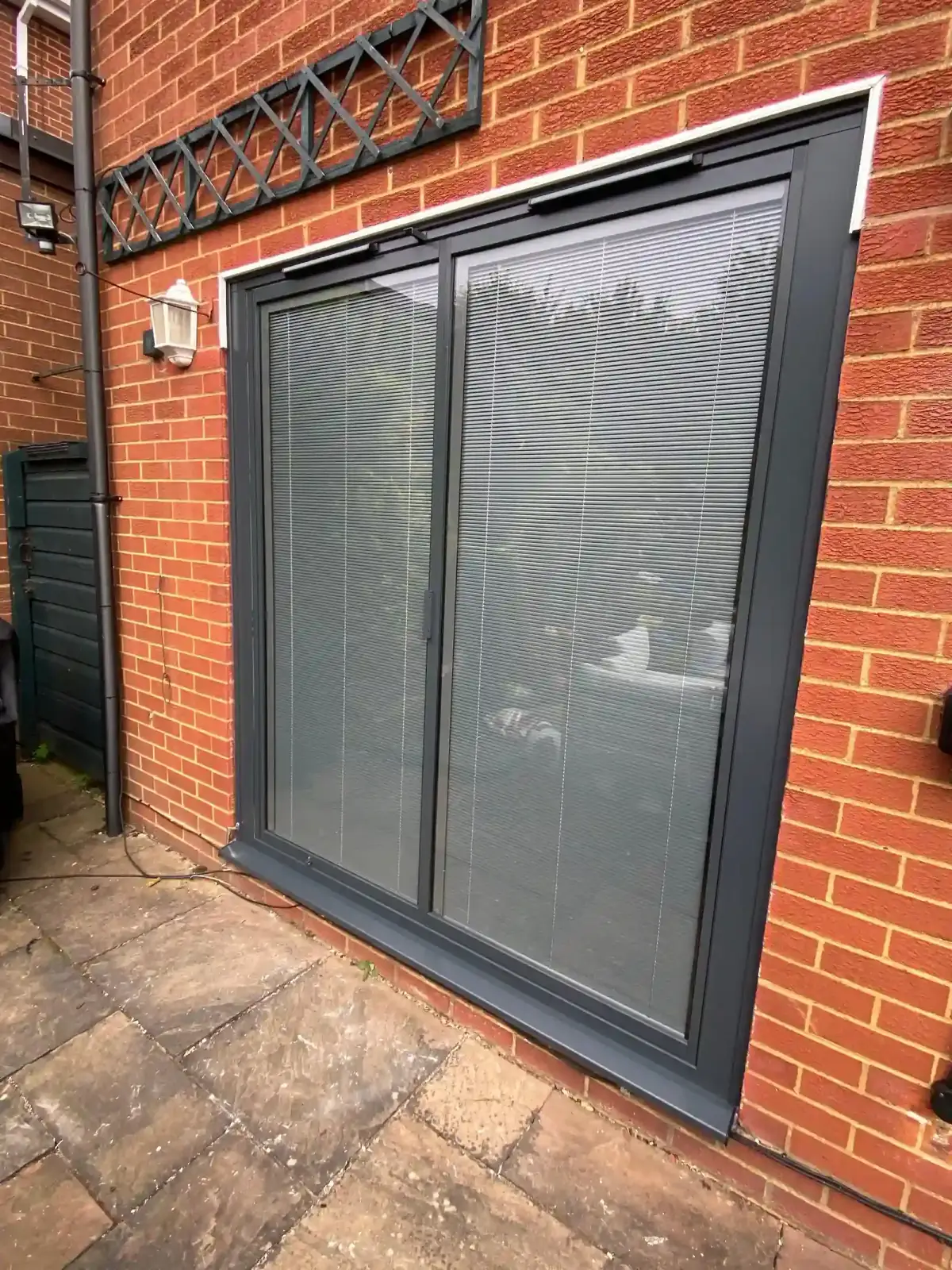
For those seeking privacy and light control, built-in blinds (also known as integral blinds) are an excellent option for concertina glass doors. These blinds are integrated between the glass panes, protecting them from dust or damage. They can be raised, lowered, and tilted with a magnetic slider on the side of the door panel.
Bifolding doors with built in blinds offer several advantages over traditional window coverings. They don’t require cleaning, as they’re sealed within the glazing unit. This makes them particularly useful in kitchens or bathrooms where hygiene is a priority. The sleek design of integrated blinds complements the clean lines of concertina glass doors, maintaining a tidy appearance even when the blinds are in use.
These systems come in various styles and colours, allowing you to match them to your interior design scheme. Some manufacturers offer motorised options for glazed concertina doors, allowing you to control the blinds with a remote.
Dual Colour Options
Two-tone colour schemes provide an opportunity to give your coloured bifold doors a unique look. This option allows you to choose different colours for the interior and exterior faces of the door frames. It’s a practical way to match your doors to both your home’s exterior and interior decor.
For example, you might opt for a classic white finish on the inside to coordinate with your interior walls, while choosing a bolder colour for the exterior to make a statement or complement your home’s facade. This flexibility can be particularly useful when installing concertina glass doors in conservation areas where specific external colours may be required.
The two-tone option is available for most frame materials, including aluminium and uPVC.
Door Hardware Choices
The hardware you choose for your concertina glass doors can have a big impact on both their appearance and functionality. Handles, locks, and hinges are available in a range of styles and finishes, from modern brushed stainless steel to traditional brass.
For external doors, the main handle typically includes a multi-point locking system for security. You can choose from lever handles, which are easy to use and suit most styles, or pull handles for a more minimalist look. Some systems offer flush handles that sit within the frame when not in use, creating a streamlined appearance.
The colour and finish of your hardware can complement or contrast with your door frames. For example, black hardware can create a striking look against white or light-coloured frames. Consider how the hardware will look from both inside and outside, especially if you’ve opted for a two-tone colour scheme on your glazed concertina doors.
Concertina Glass Doors FAQ
What are concertina glass doors?
Concertina doors with glass, also known as bifold door systems or bifolding doors, are a type of door that folds back on itself in sections. They typically consist of multiple glass panels connected by hinges, allowing them to fold and stack neatly to one side when opened. These doors offer a flexible way to open up large areas of a wall.
How do concertina doors differ from sliding doors?
The main difference between sliding doors and bifold doors lies in their opening mechanism and space requirements. Sliding doors (also known as patio doors when used externally) move horizontally along a track, with panels overlapping each other when open, while concertina doors fold and stack to one side. Bifold doors can open up a larger aperture than sliding doors, but they require more clearance space when fully opened.
How secure are concertina glass doors?
External bifolding doors can be highly secure when properly installed and fitted with quality locking systems. Most modern concertina doors feature multi-point locking mechanisms that secure the doors at various points along the frame. Toughened or laminated glass options can provide extra security and safety.
Can concertina doors be used as room dividers?
Yes, concertina doors can be excellent as folding room divider doors within a home or office. Slimline internal bifold doors offer flexibility by allowing you to open up or close off areas as needed. When open, they create a spacious, open-plan feel, and when closed, they provide privacy and can help with noise reduction between rooms.
What’s the difference between uPVC and aluminium frames for glass concertina doors?
Aluminium doors are generally stronger and more durable than uPVC, allowing for slimmer frames and larger glass panels. They’re also highly resistant to corrosion and can be finished in a wide range of colours. uPVC frames, on the other hand, are typically less expensive and offer better thermal insulation, but they tend to have chunkier profiles.
Can glass concertina doors be used as a primary entrance?
While folding external doors can be used as a primary entrance, it’s important to consider factors such as security, weatherproofing, and daily practicality. Many homeowners opt to include a separate pedestrian door within the bifold system or nearby for everyday use. This arrangement allows for easy access while retaining the option to fully open the bifold doors when desired.
Are glass concertina doors suitable for commercial properties?
Concertina doors are indeed suitable for commercial properties. They offer a modern, sleek look while providing the flexibility to create open or closed spaces as needed. In office environments, glass bifold internal doors can help manage noise levels, create private meeting areas, and adapt the space for different uses throughout the day.
About SunSeeker Doors
With over 20 years of experience, SunSeeker Doors remains at the forefront of door design with our quality-tested patio doors and related products, including the bespoke UltraSlim aluminium slide and pivot door system, Frameless Glass Doors, and Slimline Sliding Glass Doors. All of our doors are suitable for both internal and external use.
To request a free quotation, please use our online form. You may also contact 01582 492730, or email info@sunseekerdoors.co.uk if you have any questions.


